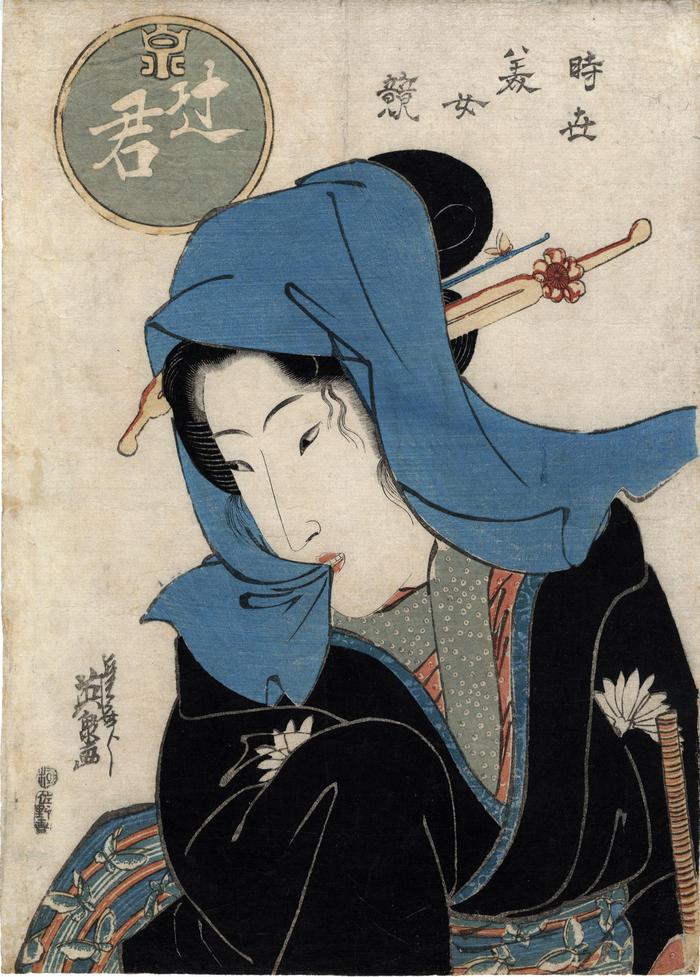Keisai Eisen (渓斎英泉) (artist 1790 – 1848)
Streetwalker (Tsujigimi - 辻君) from the series Comparison of Present-day Beauties (Jisei bijin kurabe - 時世美人競)
1825
10.25 in x 14.25 in (Overall dimensions) Japanese color woodblock print
Signed: Keisai Eisen ga (渓斎英泉画)
Artist's seal: Sen in circular cartouche
Publisher: Sanoya Kihei
(Marks 446 - seal 25-210)
Censor's seal: kiwame
Museum of Fine Arts, Boston
Museum of Fine Arts - Utamaro of a tsujigimi from ca. 1795
National Diet Library - Toyokuni III using the same motif in 1863 This Eisen print has a precedent/model in a design by Utamaro from ca. 1795. The connections are undeniable. Both women are wearing black robes. Not only are they both images of beautiful women, but both show a woman with a cloth covering their hair. Each of them is holding that cloth by their teeth - a motif rich in sexual symbolism obvious to the late eighteenth and early nineteenth century print buyers.
Another connection is in the title and the use of the term 'tsujigimi'. In the catalogue, The Passionate Art of Kitagawa Utamaro by Clark and Asano it says: "Tsuji-gimi (literally 'crossroads girl') or yotaka ('night-hawk') were the pejorative names given in Edo to street-walkers, prostitutes of the lowest level."
Clark goes on to note that the woman in the Utamaro print is too beautiful to be a low-class prostitute. The same could be said for the woman used as a model for the Eisen print shown here.
****
There are ten known print in this series. The Museum of Fine Arts in Boston dates their copy of this print to the 1830s, but the 浮世絵師溪斎英泉, 千葉市美術館 (Keisai Eisen: Artist of the Floating World, Chiba City Museum, 2012, pp. 76-77, lists all four from this series shown as from 1825. Robert Schaap and Glenn van den Bosch in an article of Andon from April, 2018 date this series to ca. 1822, but note that there is a later edition with some changes in the design of the clothes. (JSV)
The Museum of Fine Arts in Boston gives the title of this series as Jisei bijin kurabe (時世美人競). However, other institutions and sites in Japan give the kanji as 今世美女競 which can be transliterated as Jise bijo kurabe or Jisei bijo kura or even Imayō bijo kurabe..
****
One other point: Click on the Eisen image and enlarge it so you can see more clearly the design of the woman's obi. It shows butterflies apparently flying over a striped design which hints at flowing water.
****
In another one of the prints from this series a bijin is looking down at a packet of white powder sold by Bien Senjoko which she is holding in her left hand. That may well indicate that that company may have underwritten the production of the entire series or they may have only paid for product placement on that one print.
****
Sebastian Izzard noted, in speaking of a different series by Kunisada, that one of the prints in this set displays "...a packet of Bien Senjokō (Beautiful fairly maiden fragrance), a popular cosmetic whose brand name was based on the poetry name (haimyō) Rokō, of the Kabuki actor Segawa Kikunojō V (1802-32), one of Edo's leading contemporary onnagata, or players of female roles. It was manufactured by Sakemoto, a man who often used beauty and landscape prints to promote his products. Indeed, selling this kind of advertising was a common way for publishers, such as Azumaya to defray the expenses of producing prints."
****
Illustrated
1) in color in 原色浮世絵大百科事典 (Genshoku Ukiyoe Daihyakka Jiten), vol. 1, p. 73, #111.
2) in a full-page color reproduction in Masterpieces of the Japanese Color Woodcut by Willy Boller, Boston Book and Art Shop, 1957, pp. 136-137. This image was printed on the dust jacket.
****
There is another copy of this print in the Shimane Art Museum. They date their copy to 1825.
beautiful woman picture (bijin-ga - 美人画) (genre)
Sanoya Kihei (佐野屋喜兵衛) (publisher)
